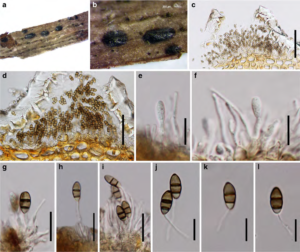Seimatosporium pseudorosarum Wijayaw., Camporesi & K.D. Hyde, in Ariyawansa et al., Fungal Diversity: 10.1007/s13225-015-0346-5, [130] (2015)
Index Fungorum number: IF551182; Facesoffungi number: FoF00670
Etymology – Named as its morphological similarity to Seimatosporium rosarum.
Holotype – MFLU 15-0745
Saprobic or endophytic on living branches and stems of Rosa canina L. Sexual morph: Undetermined. Asexual morph: Conidiomata 200–250 μm diam., 100–150 μm high, acervular, unilocular, subglobose, superficial to subepidermal, solitary, black, ostiolate, apapillate. Conidiomata wall multi-layered, outer wall thick, composed of dark brown cells of textura angularis, inner wall thin, hyaline. Paraphyses 10–22 μm, filiform, cylindrical, aseptate, hyaline, smooth-walled. Conidiophores 6–25×2– 4 μm, long, cylindrical, branched, hyaline, smooth-walled. Conidiogenous cells holoblastic, annellidic, simple, integrated, determinate, hyaline. Conidia 9–14×4–6 μm (x = 11.31×6.06 μm, n=20), ellipsoid to obovoid, obtuse apex and base, straight, 2-septate, with brown to dark brown septa, constricted at the septa, eguttulate, medium brown, with hyaline to sub-hyaline basal cell, smooth-walled, with or without basal appendage, if present appendages 9– 30 μm, unbranched.
Culture characteristics: On PDA slow growing, white from above, pale brown from below, flat, margin even, attaining a diam. of 2 cm in 7 days at 18 °C.
Material examined – ITALY, Province of Rimini [RN], near Pennabilli–Rimini, on dead branch of Rosa canina (Rosaceae), 22 March 2014, Erio Camporesi, IT 1770 (MFLU 15-0745 holotype), living cultures MFLUCC 14–0466, GUCC 66.
Notes – Fa r r and Rossman (2015) r e p o r t e d Seimatosporium caudatum (Preuss) Shoemaker, S. discosioides (Ellis & Everh.) Shoemaker, S. lichenicola
(Corda) Shoemaker & E. Müll., S. rosae Corda, S. rosarum (Henn.) B. Sutton and S. salicinum (Corda) Nag Raj from Rosa spp. Our collection morphologically resembles S. rosae, S. rosarum and S. salicinum as it has conidia with only basal appendages. However, S. pseudorosarum has only 2-septate conidia, while all other species have 2–3 or 3 septa. Hence, we introduce our species as a new species of Seimatosporium. The following taxonomic key can be used to distinguish S. pseudorosarum from other species occurring on Rosa spp.

Fig. 1 Seimatosporium pseudorosarum (holotype) a, b Conidiomata on Rosa villosa c, d Cross sections of conidiomata e–i Different stages of conidiogenesis and paraphyses j–l Conidia. Scale bars: c, d=100 μm, e, f, j–l=10 μm, g–i=15 μm
